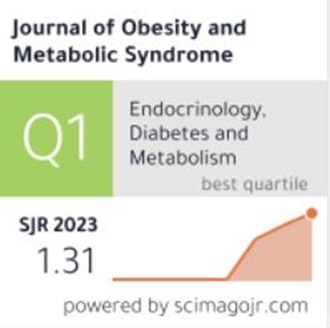甘油三酯-葡萄糖指数预测代谢不健康肥胖人群心血管结局:一项基于全国人群的队列研究[J] .中国医学杂志,2022;31:178-86)。
IF 7.9
Q1 ENDOCRINOLOGY & METABOLISM
引用次数: 0
摘要
本文章由计算机程序翻译,如有差异,请以英文原文为准。
Response: Triglyceride-Glucose Index Predicts Cardiovascular Outcome in Metabolically Unhealthy Obese Population: A Nationwide Population-Based Cohort Study (J Obes Metab Syndr 2022;31:178-86).
J Obes Metab Syndr 2023;32:181-182 The triglyceride glucose (TyG) index is considered a surrogate marker of cardiovascular disease (CVD) and mortality using the parameter of insulin resistance. Numerous studies have investigated the associations between the TyG index and cardiovascular outcomes, including cardiovascular mortality. A recent meta-analysis and systematic review evaluated associations between the TyG index and the risks of CVD and mortality in the general population.1 Twelve cohort studies involving 6,354,990 participants were analyzed. Higher TyG index values were significantly associated with an increased incidence of CVD; however, the TyG index was not correlated with mortality, including cardiovascular mortality in analyses.1 A subgroup analysis of the population without diabetes revealed no significant association between myocardial infarction incidence and the TyG index, indicating the heterogeneous implications of this index across populations.2 The present study contributes to the literature because we focused on the specific population in which the TyG index could be a useful surrogate marker for an elevated CVD risk.3 Our results demonstrated that the TyG index could predict CVD mortality only in participants with metabolically unhealthy obesity (MUO), and that the index is substantially and consistently associated with CVD regardless of the metabolic health phenotype or presence of obesity.3 In a letter to the editor, the author stated that assessing the predictive value of the TyG index for CVD outcomes would provide greater benefit if we considered changes in the TyG index as well as the obese metabolic health phenotype. Several recent studies have reported the significant effect of longitudinal changes in the TyG index on CVD risk. We appreciate the letter author for highlighting these important points. A study involving 62,443 healthy Chinese people found that CVD risk increased with quartile of change in the TyG index during a median follow-up of 7.01 years, and that adding change in the TyG index to a baseline risk model for CVD improved its predictive power.4 Another prospective cohort study involving 36,359 participants with a median observation period of
求助全文
通过发布文献求助,成功后即可免费获取论文全文。
去求助
来源期刊

Journal of Obesity & Metabolic Syndrome
ENDOCRINOLOGY & METABOLISM-
CiteScore
8.30
自引率
9.60%
发文量
39
审稿时长
19 weeks
期刊介绍:
The journal was launched in 1992 and diverse studies on obesity have been published under the title of Journal of Korean Society for the Study of Obesity until 2004. Since 2017, volume 26, the title is now the Journal of Obesity & Metabolic Syndrome (pISSN 2508-6235, eISSN 2508-7576). The journal is published quarterly on March 30th, June 30th, September 30th and December 30th. The official title of the journal is now "Journal of Obesity & Metabolic Syndrome" and the abbreviated title is "J Obes Metab Syndr". Index words from medical subject headings (MeSH) list of Index Medicus are included in each article to facilitate article search. Some or all of the articles of this journal are included in the index of PubMed, PubMed Central, Scopus, Embase, DOAJ, Ebsco, KCI, KoreaMed, KoMCI, Science Central, Crossref Metadata Search, Google Scholar, and Emerging Sources Citation Index (ESCI).
 求助内容:
求助内容: 应助结果提醒方式:
应助结果提醒方式:


